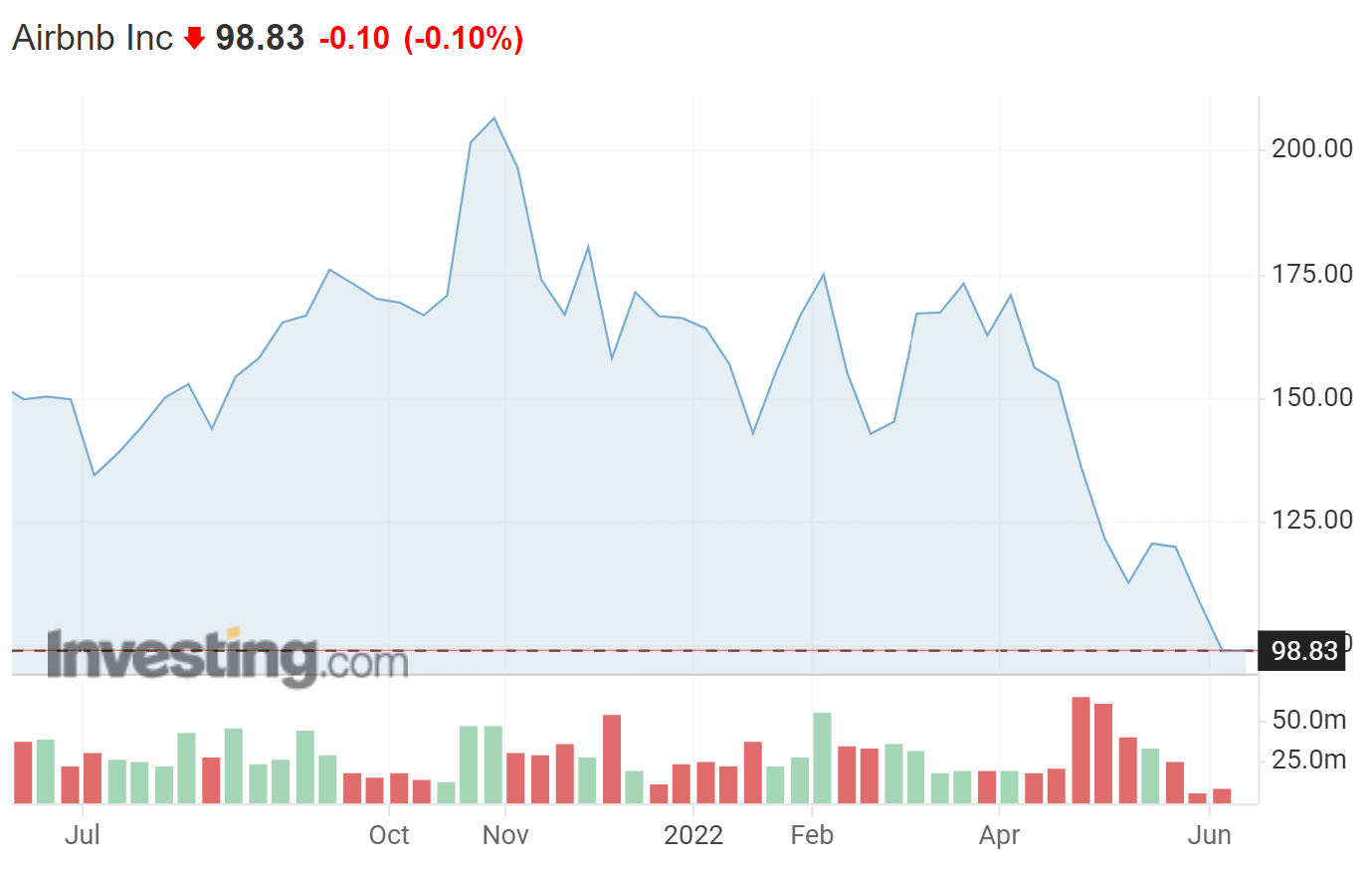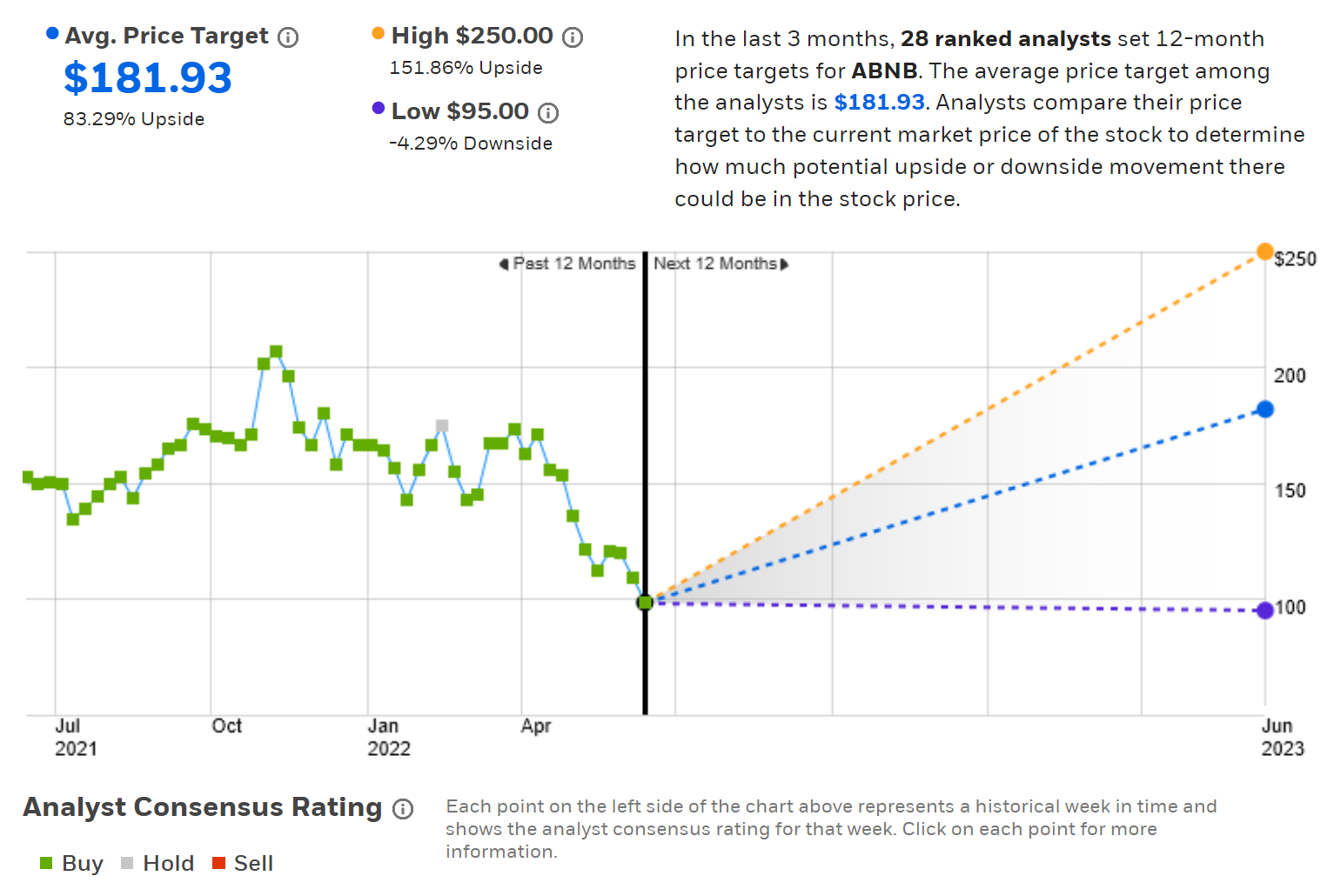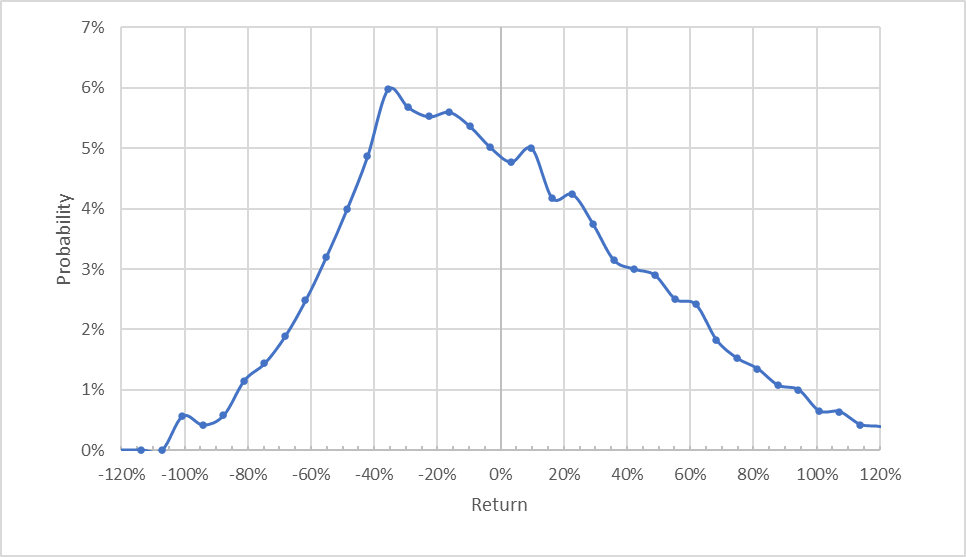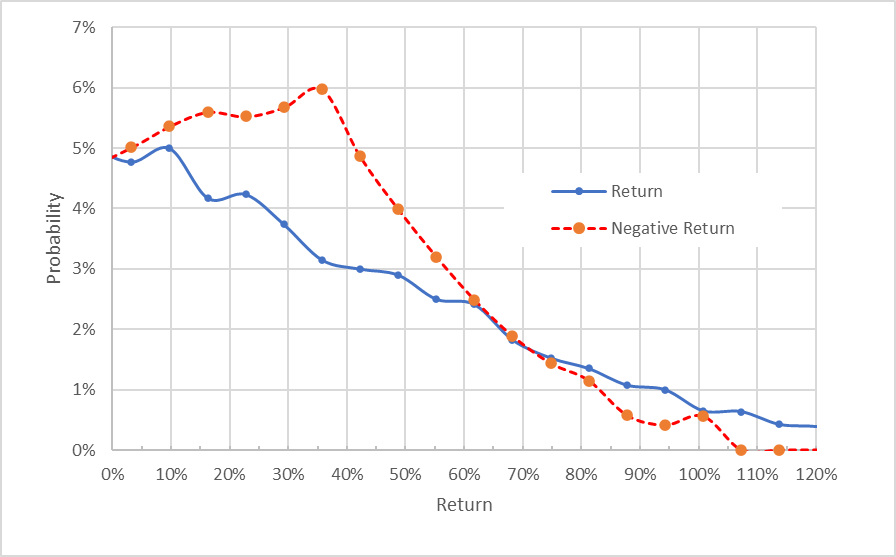- ABNB has fallen more than 40% so far in 2022
- The valuation is still high, with 12-month P/E of 84.7 and forward P/E of 51.7
- The Wall Street consensus outlook is bullish
- The market-implied outlook continues to be bearish, with high volatility
- For tools, data, and content to help you make better investing decisions, try InvestingPro+
As concerns about a possible recession grow, the travel and leisure industry has sold off. This comes at a particularly trying time for Airbnb (NASDAQ:ABNB), which is also experiencing downward pressure due to rising interest rates.
Stocks with high price-to-earnings (P/E) ratios tend to be particularly sensitive to interest rates because the discount factor applied to future earnings has a larger impact when valuations are based on earnings that are expected to occur further out in time.
Another risk factor with rising rates is that the economics of vacation rentals become less attractive. With rising mortgage rates, ABNB hosts may need to charge higher fees, reducing the relative attractiveness of this type of accommodation.
In addition, the potential default rates for non-owner rentals in times of financial stress are expected to be considerably higher than for owner-occupied properties (see previous link). Defaults among hosts do not directly impact ABNB but would tend to raise rental fees and reduce the number of hosts.

Source: Investing.com
Shares in the travel and experience platform are currently trading 52% below the 12-month high closing price of $207.04 on Nov. 6, 2021. The shares are down 33.4% over the past 12 months, with a slightly smaller decline than the travel services industry, as defined by Morningstar.
The San Francisco-based tech giant reported Q1 results on May 6, beating expectations on earnings and revenue. Revenue increased by a massive 70% over the past year, but, of course, this is largely due to depressed travel levels from last year.
By any measure, ABNB is growing at a robust rate, with more than 100 million bookings in Q1, an all-time high for a single quarter. In addition, people tend to be staying longer in Airbnb accommodations and paying more per night. There are currently 6 million active Airbnb listings.
ABNB’s trailing 12-month (TTM) P/E ratio is 84.7 and the forward P/E (calculated using estimated earnings over the next 12 months) is 51.7. This is a rich valuation in market conditions in which investors are becoming more skeptical about ‘growth at any price’.
On Dec.8, shares were trading at $183 and I assigned a neutral rating. With a high-growth stock, the valuation depends almost entirely on the growth outlook. In December, the Wall Street analyst consensus rating was bullish, with a 12-month price target that was 9%-10% above the share price at that time.
By contrast, the consensus view implied by options prices, the market-implied outlook, was significantly bearish, and indicated that the most-probable outcomes were significant declines. In compromising between the outlooks from the Wall Street analysts and the buyers and sellers of options, I compromised with a neutral rating.
For readers who are unfamiliar with the market-implied outlook, a brief explanation is needed. The price of an option on a stock is largely determined by the market’s consensus estimate of the probability that the stock price will rise above (call option) or fall below (put option) a specific level (the option strike price) between now and when the option expires. By analyzing the prices of call and put options at a range of strike prices, all with the same expiration date, it is possible to calculate a probabilistic price forecast that reconciles the options prices. This is the market-implied outlook. For a deeper explanation and background, I recommend this monograph published by the CFA Institute.
With about six months since my last analysis, and the shares trading at a substantial discount to their levels at the end of 2021, I have calculated a market-implied outlook through the end of 2022 and compared this with the current Wall Street consensus outlook, in revisiting my rating on ABNB.
Wall Street Consensus Outlook For ABNB
E-Trade calculates the Wall Street consensus outlook by combining the views of 28 ranked analysts who have published ratings and price targets for ABNB over the last three months. The consensus rating for ABNB is bullish, with a consensus 12-month price target that is 83% above the current share price. The 12-month price target is lower than the value in early December, but the substantial drop in the shares price since then results in the very high expected price appreciation over the next year.
One red flag in the consensus is that there is very high dispersion among the individual price targets, with the highest ($250) more than 2.5 times the lowest ($95). Research shows that the predictive value of the consensus price target gets lower as the dispersion among the individual price targets increases. At very high dispersion, the correlation between the precise appreciation implied by the consensus price target and subsequent returns is negative.

Source: E-Trade
Investing.com’s version of the Wall Street consensus outlook is calculated using ratings and price targets from 39 analysts. The results are very similar to those from E-Trade.

Source: Investing.com
The current Wall Street consensus outlook implies enormous return expectations for ABNB over the next year, particularly as compared with the consensus outlook from December. What is less encouraging is that the dispersion among the individual price targets is very large, reducing confidence in the meaningfulness of the consensus as a predictor.
Market-Implied Outlook For ABNB
I have calculated the market-implied outlook for ABNB for the 7.2-month period from now until Jan. 20, 2023, using the prices of call and put options that expire on this date. I chose this specific expiration date to provide a view through the end of 2022 and because the options expiring in January are particularly actively traded.
The standard presentation of the market-implied outlook is a probability distribution of price return, with probability on the vertical axis and return on the horizontal axis.

Source: Author’s calculations using options quotes from E-Trade
The most notable feature of the outlook for ABNB to early 2023 is the positive skewness, with the peak in probability substantially tilted to favor negative returns. The maximum probability corresponds to a price return of -35% over this period. The expected volatility calculated from this outlook is 63% (annualized). This market-implied outlook is qualitatively very similar to the results back in December. Research has found that stocks with positive skewness in the market-implied outlook tend to underperform.
To make it easier to directly compare the relative probabilities of positive and negative returns, I rotate the negative return side of the distribution about the vertical axis (see chart below).

Source: Author’s calculations using options quotes from E-Trade. The negative return side of the distribution has been rotated about the vertical axis.
This view emphasizes that the probabilities of negative returns are much higher than for positive returns of the same magnitude, across a wide range of the most probable outcomes (the dashed red line is well above the solid blue line over most of the left half of the chart above). The probabilities of very large positive returns are higher than for same-size negative returns, but these outcomes occur at very low overall probability.
Theory indicates that the market-implied outlook is expected to have a negative bias because investors, in aggregate, are risk averse and thus tend to overpay for downside protection (e.g. put options), although there is no way to directly measure the magnitude of this effect. Even considering the potential for a negative bias, the negative orientation of this outlook is large. This is a bearish outlook for ABNB from the options market.
Summary
ABNB has dropped more than 40% so far in 2022 on recession fears and rising interest rates, even though it is growing at a healthy clip. Even at current levels, the valuation remains quite high.
The Wall Street consensus rating is bullish, as it has been over almost all of the past year. The consensus 12-month price target is slightly lower than at the end of 2021 but the large share price declines have resulted in the consensus price target being more than 80% above the current share price.
The market-implied outlook is strongly bearish, as it was back in early December when I last ran this analysis. The estimated maximum-probability outcome for the period from now until January of 2023 is -35% and the expected volatility is 63% (annualized).
In balancing the bullish Wall Street consensus outlook with the bearish market-implied outlook, and considering the company’s solid execution during a very trying period for travel and leisure stocks, I am maintaining my neutral rating on ABNB.
***
Interested in finding your next great idea? InvestingPro+ gives you the chance to screen through 135K+ stocks to find the fastest growing or most undervalued stocks in the world, with professional data, tools, and insights. Learn More »
